Night falls in Brazil’s Amazon and two logging trucks without license plates emerge from the jungle. They rumble over dirt roads that lead away from a national forest, carrying trunks of trees hundreds of years old.
After pulling onto a darkened highway, the truckers chug to their turnoff into the woods, where they deliver their ancient cargo. By morning, the trunks are laid out for hewing at the remote sawmill, its corrugated metal roof hardly visible from the highway.
The highway known as BR-163 stretches from soybean fields to a riverside export terminal. The loggers were just south of the road’s juncture with BR-230, known as the Trans-Amazon. Together the highways cover more than 5,000 miles, crossing the world’s fifth-biggest country in the state of Para.
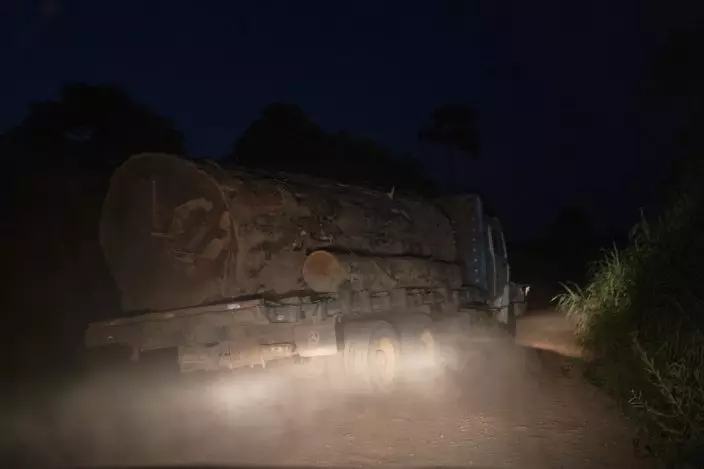
In this Nov. 28, 2019 photo, a logging truck without license plates carries the trunk of a giant tree on a dirt road away from Trairao National Forest in Trairao, Para state, Brazil. Night after night, truckers chug along the darkened road to their turn-off into the woods, where they deliver their ancient cargo. By morning, the logs are laid out for hewing at the remote sawmill, its corrugated metal roof hardly visible from the highway. (AP PhotoLeo Correa)
Carved through jungle during Brazil’s military dictatorship in the 1970s, the roads were built to bend nature to man’s will in the vast hinterland. Four decades later, there’s development taking shape, but also worsening deforestation — and locals harbor concerns that progress may pass them by.
Colonization Dream
The highways first meet in the city of Ruropolis, where the military government promised land to lure people to the planned agricultural village. One 53-year-old man, Hilquias Soares, remembers a state agent in his hometown yelling, “Who wants to go to Para?”
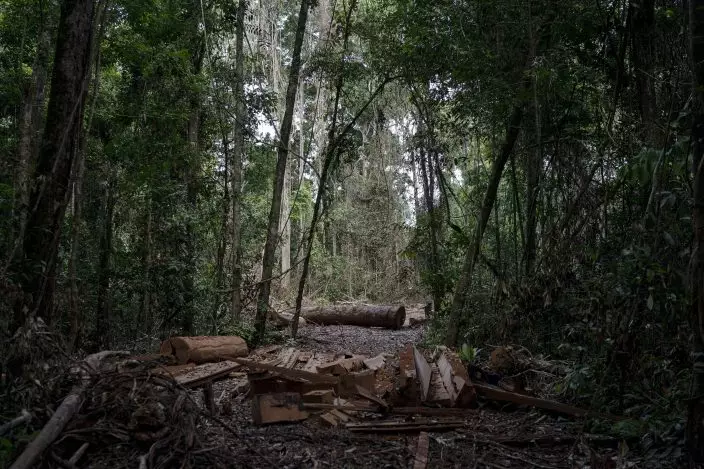
In this Nov. 22, 2019 photo, cut logs and wooden boards lie in an area opened by illegal loggers within the Renascer Reserve in the Amazon rainforest in Prainha, Para state, Brazil. This conservation unit is known to have trees with high economic value such as ipe, jatoba and massaranduba. One of the biggest seizures of illegal timber in the Brazilian Amazon forest happened in this reserve in 2010. (AP PhotoLeo Correa)
His family took the chance, arriving just after President Emílio Médici, a general, inaugurated the town. Archival footage shows Médici unveiling a plaque reading: “The Brazilian people respond to the challenge of history, occupying the heart of the Amazon.” Children play on see-saws and show off T-shirts with the crossroads sprawling across the continent-sized nation.
“There was a dream of colonization, of getting land and seeing if here we could have better financial conditions,” Dedé Diniz, 69, said in his home. “A lot of people don’t recognize what we did, what we fought for.”
Diniz examines a photograph he took of Médici and, below it in his album, a shot of a truck trapped in mud. It’s nothing like the bucolic painting on his wall that shows farm furrows and wild forest beside the highway, where a machine repairs ruts.
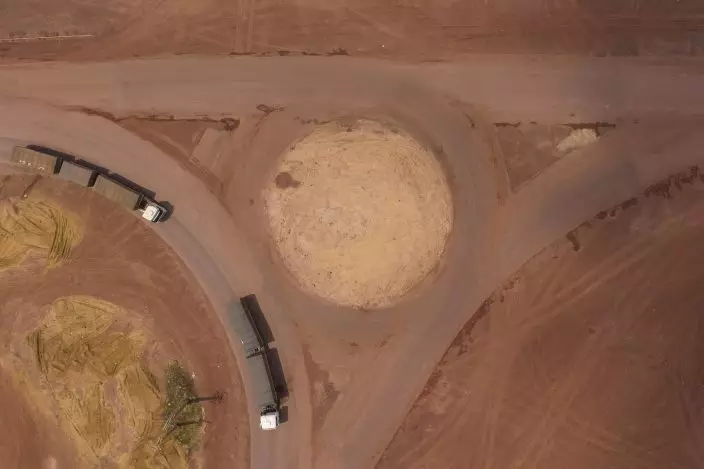
In this Nov. 29, 2019 photo, cargo trucks turn off the Trans-Amazon highway, top, onto route BR-163 in Campo Verde, near Itaituba, Para state, Brazil. Carved through jungle during Brazil's military dictatorship in the 1970s, the roads were built to bend nature to man's will in the vast hinterland. Four decades later, there's development taking shape, but also worsening deforestation_ and locals harbor concerns that progress may pass them by. (AP PhotoLeo Correa)
He jokes that he’ll update the painting with asphalt soon — that stretch should be paved by 2021. Already people have started moving in from other states to buy land for cattle pastures.
Brazil’s President Jair Bolsonaro, a former Army captain, won last year’s election with support from farmers, truckers and miners by resurrecting the dictatorship-era desire to develop the world’s largest tropical rainforest. But he did so at a different stage of human history, one where scientists recognize the Amazon must remain to suck carbon from the air and help arrest climate change. Some also argue the Amazon, which has lost some 20% of its original forest, is nearing an irreversible tipping point. In that sense, Brazil itself is at a crossroads.
Road Warriors
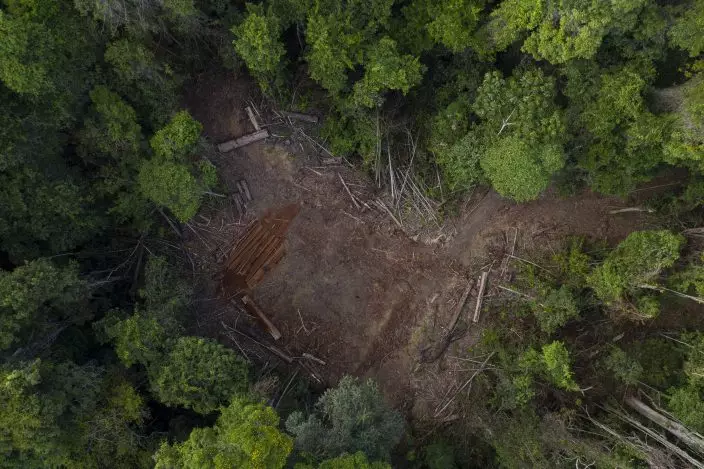
In this Nov. 22, 2019 photo, cut logs lie in an area opened by illegal loggers inside the Renascer Reserve in the Amazon rainforest in Prainha, Para state, Brazil. This area is known to have trees with high economic value such as ipe, jatoba and massaranduba. One of the biggest seizures of illegal timber in the Brazilian Amazon forest happened in this reserve in 2010. Those who live in the area complain that illegal logging is still happening. (AP PhotoLeo Correa)
From Ruropolis, the Trans-Amazon and BR-163 run jointly westward over a bumpy 70 miles before splitting at a little roundabout. During corn and soy harvests, 2,600 trucks pass through each day to and from the nearby Tapajos River.
There, trucks pull into transshipment ports. Grain cascades from their containers to be loaded onto barges. After a downriver trip that takes days, the grain is poured into ships’ holds and dispatched across the world, largely to China.
That transoceanic network seems far removed from the road warriors filling up on grilled beef or bowls of açai in truck stops. While the truckers eat, grease-stained mechanics replace worn-out shocks and blown-out tires.
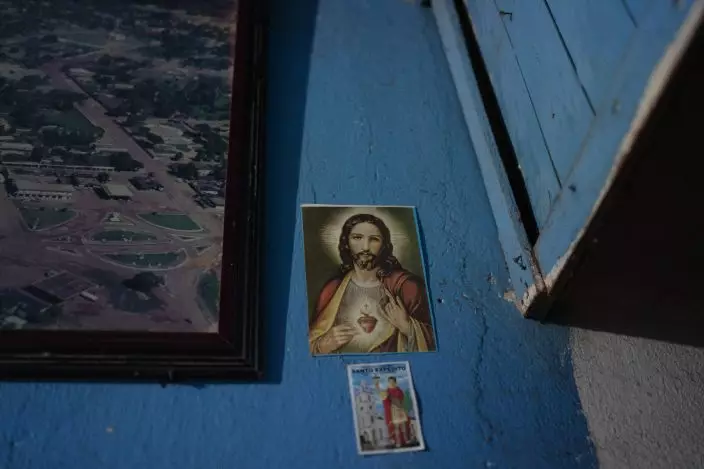
In this Nov. 29, 2019 photo, an image of sacred heart of Jesus hangs on a wall in Dede Diniz's home in the town of Ruropolis, Para state, Brazil, next to an aerial photo of the town. The Trans-Amazon highway and route BR-163 meet in the city of Ruropolis, where the military government promised land to lure people to the planned agricultural village in the 1970s. (AP PhotoLeo Correa)
At the start of Bolsonaro’s administration, only 32 miles of BR-163 from soy country to the Trans-Amazon remained to be paved. But tropical rains transformed the dirt into impassable mud. Soy trucker Sandro Vieira recalled being stuck in gridlock two years ago, consuming nothing but bread, coffee and peanuts for a week; to this day, the smell of peanuts disgusts him.
Bolsonaro’s government last month finished paving the soy corridor. The decades-delayed achievement is the first of major public works to come, Infrastructure Minister Tarcísio de Freitas said. They include a $3 billion grain railway alongside BR-163.
A ministry promotional video for foreign investors shows deer and other wild animals in their habitats, living in harmony with highways.

In this Nov. 29. 2019 photo, an otter pelt hangs on the wall behind Dede Diniz in his home in the town of Ruropolis, Para state, Brazil. Diniz remembers the visit of President Emilio Medici, during his military dictatorship, at the time the town was inaugurated. "There was a dream of colonization, of getting land and seeing if here we could have better financial conditions," said Diniz in his home. (AP PhotoLeo Correa)
“We know Brazil has a responsibility to the world, and we will fulfill our responsibility,” de Freitas said.
Improved Access
The two highways opened up the rainforest — and viewed from above, the landscape is slashed by jagged stitches of cleared forest on both sides.
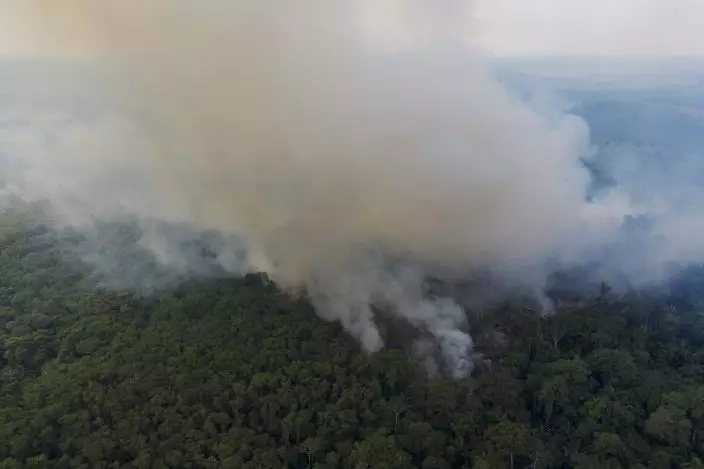
In this Nov. 29, 2019 photo, smoke rises from a fire in the Amazon rainforest near route BR-163 and the Trans-Amazon highway in Ruropolis, Para state, Brazil. Official data show Amazon deforestation rose almost 30% in the 12 months through July, to its worst level in 11 years. Para state alone accounted for 40% of the loss, especially along the Trans-Amazon and BR-163 highways. (AP PhotoLeo Correa)
Roads themselves aren’t the problem today, according to Paulo Barreto, a forest engineer and researcher at environmental group Imazon.
The issue, he said, is that improved access has been accompanied by Bolsonaro’s rhetoric emboldening illegal loggers while his administration undermines its own environmental regulator.
“If those things continue, deforestation will explode in the area,” Barreto said.
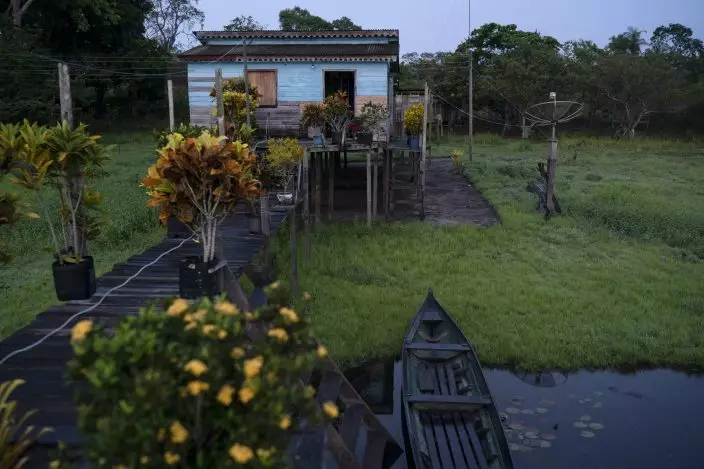
In this Nov. 22, 2019 photo, a wooden house stands at dawn in the Renascer Reserve in the Amazon rainforest in Prainha, Para state, Brazil. The clock is ticking. Already the Amazon is growing warmer and drier, losing its capacity to recycle water, and may become savannah in 15 to 30 years, said Carlos Nobre, a climate scientist at the University of Sao Paulo. (AP PhotoLeo Correa)
Official data show Amazon deforestation rose almost 30% in the 12 months through July, to its worst level in 11 years. Para state alone accounted for 40% of the loss, with a heat map of incidents running along the Trans-Amazon and BR-163. The Jamanxim national forest, alongside BR-163, had the second most deforestation of any protected area.
Paulo Bezerra, a leader of the Munduruku indigenous people that live around the highways, said in an interview that farmers from Mato Grosso and other states are using tractors to rip down trees near his village, and try to intimidate tribesmen into silence. They say they’re afraid of being killed.
After the global spotlight turned to Brazil in August as the Amazon burned, Bolsonaro dismissed the huge fires as normal practice for clearing pasture and farmland.

In this Nov. 21, 2019 photo, 10-year-old Kevin performs a somersault in the Uruara river as his friend looks on, at the entrance of the Renascer conservative unit of the Amazon rainforest in Prainha, Para state, Brazil. The clock is ticking. Already the Amazon is growing warmer and drier, losing its capacity to recycle water, and may become savannah in 15 to 30 years, said Carlos Nobre, a climate scientist at the University of Sao Paulo. (AP PhotoLeo Correa)
What kind of development should Brazil’s government encourage, and how much, are questions being asked at the U.N.’s ongoing climate conference in Madrid.
Environment Minister Ricardo Salles said in an interview in Madrid that people in the Amazon will continue to be drawn into illegal activities if there isn’t economic development.
Soy Bonanza

In this Nov. 24, 2019 photo, Paulo Bezerra, a member of the Munduruku indigenous people, works on his fruit plantation at the Acaizal village in Santarem, Para state Brazil. The 56-year-old indigenous leader says that farmers from Mato Grosso and other states are using tractors to rip down trees near his village and try to intimidate them into silence. "Because of the complaints we make, we have been threatened," said Bezerra. (AP PhotoLeo Correa)
Paving BR-163 ensures soy and corn can flow uninterrupted, making viable more farming and new riverside terminals, where the government says exports can reach 25 million tons in 2024, from 10 million tons this year.
More soy means more transport. Workers recently spread concrete at one gas station being built near the crossroads, with parking for 760 trucks.
Edeon Ferreira, executive director of soy and corn transport group Pró-Logística, said heavier traffic will add jobs at restaurants and hotels, plus generate demand for mechanics to meet truckers’ needs. He spoke while leading a group of Mato Grosso soy farmers on a 2,900-mile circuit to inspect Amazon roadways.
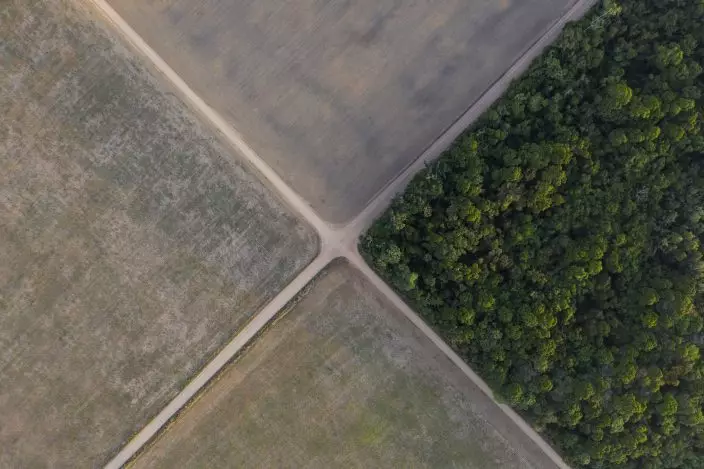
In this Nov. 30, 2019 photo, a fragment of Amazon rainforest stands next to soy fields in Belterra, Para state, Brazil. The Amazon, which has lost about 17% of its original forest, is nearing an irreversible tipping point. In that sense, Brazil itself is at a crossroads. (AP PhotoLeo Correa)
Ferreira said Mato Grosso can farm enough on degraded pasture, without deforestation, as cattle ranching becomes efficient. But Imazon’s Barreto said productivity gains don’t happen automatically; farmers will calculate whether it’s cheaper to invest in technology or clear forest areas made available, even tacitly, by the government.
To support Amazon states, Salles said Brazil aims to shore up foreign funding from the Paris Agreement. But Brazilian officials have yet to detail measures, goals or resources for anti-deforestation efforts.
The clock is ticking. Already the Amazon is growing warmer and drier, losing its capacity to recycle water, and the majority may become savannah in 15 to 30 years, said Carlos Nobre, a climate scientist at the University of Sao Paulo.
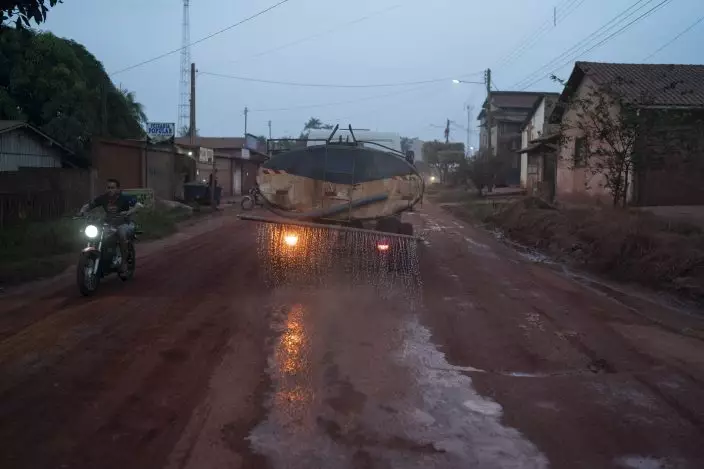
In this Nov. 29, 2019 photo, a tank truck pours water on the street at dusk in Ruropolis, Para state, Brazil. Carved through jungle during Brazil’s military dictatorship in the 1970s, the roads that meet in Ruropolis were built to bend nature to man’s will in the vast hinterland. (AP PhotoLeo Correa)
Order and Progress
Over the past two decades, soy was increasingly planted along the northern part of BR-163. On one side of the highway is the Tapajos national forest, and farmland on the other. Fires burn here and there. In one spot, the breeze carries black ash across the road into the protected area.
“The national forest is a reserve that’s important for the country, for the world,” said Manoel de Souza, 59, who coordinates the Tapajos forest’s federation of traditional communities. “Soy is also important, but it should be ordered so that they aren’t on top of one another, impacting each other.”
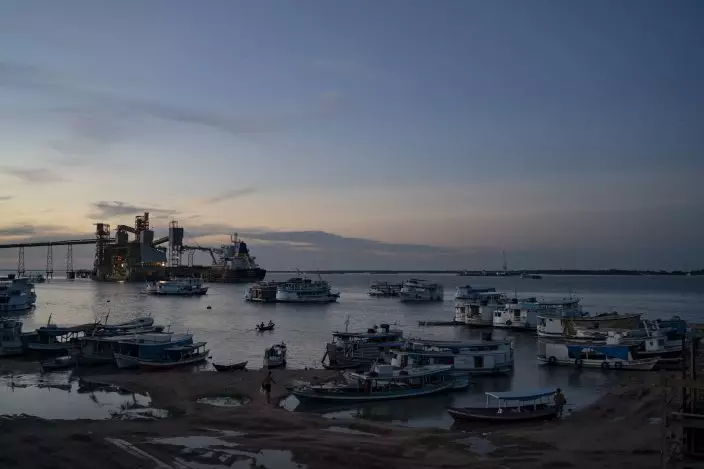
This Nov. 18, 2019 photo shows boats at dusk in a port at Santarem, Para state, Brazil, at the confluence of the Tapajos and Amazon rivers. The grain export terminal, top left, loads ships with grains, which are then dispatched across the world, largely to China. (AP PhotoLeo Correa)
Just north of the forest is Belterra, which was jungle throughout João Ferreira’s childhood. Today, his plot is an island of shade and birdsong in the middle of sweeping plantations. He’s known as João of Honey, though none of his 1,000 beehives remain. The bees died off since agribusiness moved in 20 years ago, said João, 59.
He complains that agribusiness did away with native forest, and its efficient machinery creates few jobs, leaving townspeople in the lurch. In an act of lonesome protest, he painted altered versions of the Brazilian flag and hung them over his yard. They feature question marks rather than the national motto “Order and Progress,” because he’s not sure Brazil has them any longer.
“One day progress comes," he said, "and decay arrives with it.”
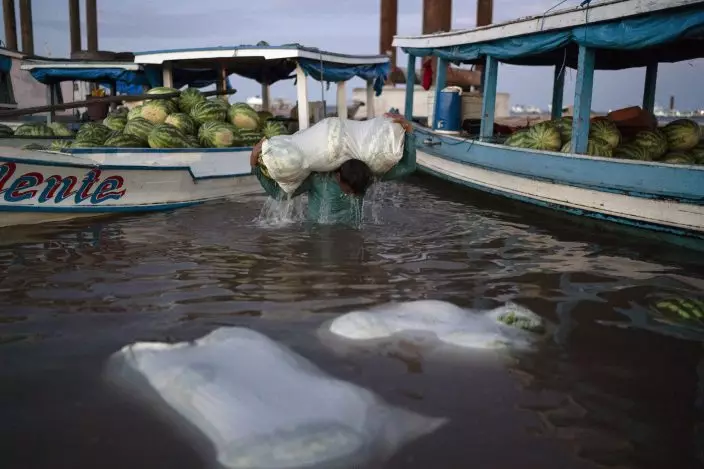
In this Nov. 18, 2019 photo, 24-year-old Donizete carries a heavy sack of watermelons through the water at the edge of the Tapajos river as he unloads a boat with goods to be delivered to the local market in Santarem, Para state, Brazil. The town, at junction of the Tapajos and Amazon rivers, is an important hub where grain is loaded onto barges for a downriver trip that takes days, then poured into ships' holds and dispatched across the world, largely to China. (AP PhotoLeo Correa)
Follow Correa on Twitter: https://twitter.com/leo_correa
AP producer Dorothee Thiesing contributed reporting from Madrid
Read more stories on climate issues by The Associated Press at https://www.apnews.com/Climate
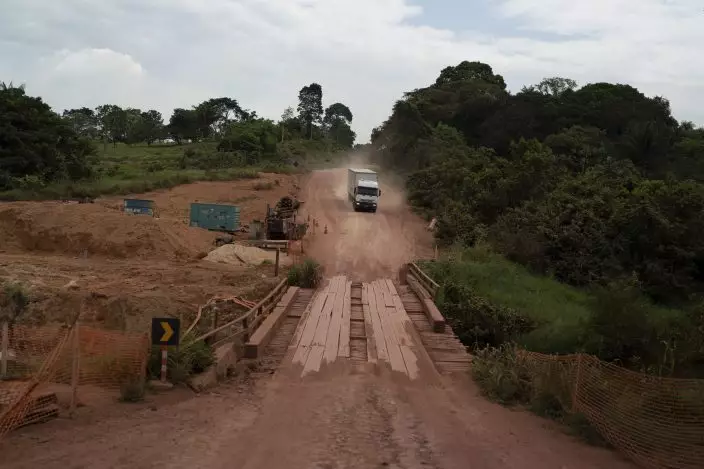
In this Nov. 26, 2019 photo, a truck drives on the road in Ruropolis, Para state, Brazil. From Ruropolis, the Trans-Amazon and BR-163 run jointly westward over a bumpy 70 miles before splitting at a little roundabout. During corn and soy harvests, 2,600 trucks pass through each day to and from the nearby Tapajos river. (AP PhotoLeo Correa)

In this Nov. 28, 2019 photo, Lauzenir Araujo stands beside his truck after removing a layer of rubber from a damaged tire on route BR-163 near Ruropolis, Para state, Brazil. Araujo, who is hauling a load of manure to a grain plantation in the state of Mato Grosso, says that the old tires tend to explode as the truck can move faster on the newer road. "Eighty percent of your life is on the road," he says. "There is no life. That's why I say, this is for those who like it." (AP PhotoLeo Correa)

In this Nov. 23, 2019 photo, a cut tree stands in a burned area in Prainha, Para state, Brazil. Official data show Amazon deforestation rose almost 30% in the 12 months through July, to its worst level in 11 years. Para state alone accounted for 40% of the loss. (AP PhotoLeo Correa)

In this Nov. 22, 2019 photo, the sun lights part of a path opened by illegal loggers in the Renascer Reserve of the Amazon rainforest in Prainha, Para state, Brazil. This area is known to have trees with high economic value such as ipe, jatoba and massaranduba. (AP PhotoLeo Correa)
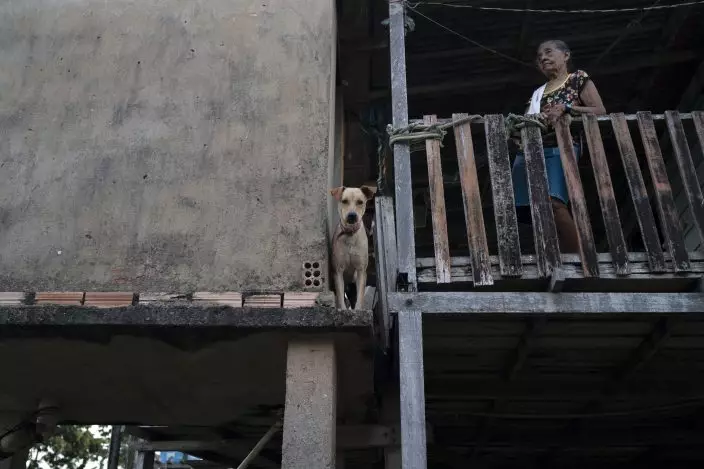
In this Nov. 27, 2019 photo, a woman stands on her stilt house with her dog, watching young boys playing soccer in the Vila Nova neighborhood of Itaituba on the Trans-Amazon highway in Para state, Brazil. The highway, carved through jungle during Brazil's military dictatorship in the 1970s, was built to bend nature to man's will in the vast hinterland. Four decades later, there's development taking shape, but also worsening deforestation, and locals harbor concerns that progress may pass them by. (AP PhotoLeo Correa)
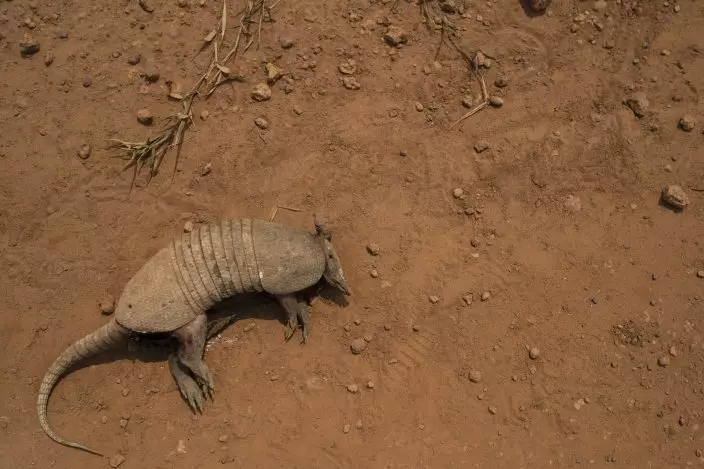
In this Nov. 29, 2019 photo, a dead armadillo lies on a dirt road in Campo Verde, near Itaituba, Para state Brazil. The clock is ticking. Already the Amazon is growing warmer and drier, losing its capacity to recycle water, and may become savannah in 15 to 30 years, said Carlos Nobre, a climate scientist at the University of Sao Paulo. (AP PhotoLeo Correa)

In this Nov. 23, 2019 photo, a burned area of the Amazon rainforest is seen in Prainha, Para state, Brazil. Official data show Amazon deforestation rose almost 30% in the 12 months through July, to its worst level in 11 years. Para state alone accounted for 40% of the loss. (AP PhotoLeo Correa)
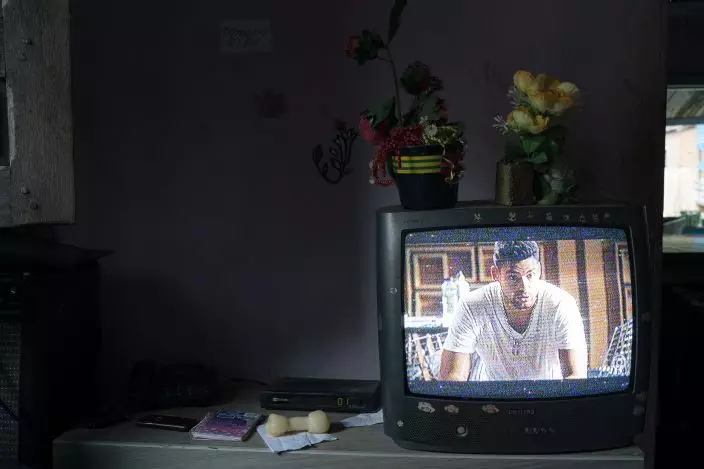
In this Nov. 28, 2019 photo, an old television transmits a Brazilian soap opera in the home of Domingas Rufina, who is a member of a local women's association in Trairao, Para state, Brazil. The 67-year-old is considering moving to another quiet town after a leader of her association was threatened after denouncing illegal logging in the nearby Trairao national forest. (AP PhotoLeo Correa)

In this Nov. 28, 2019 photo, Domingas Rufina, a member of the local women's association, poses in her home in Trairao, Para state, Brazil. The 67-year-old is considering a move to another quiet town after a leader of her association was threatened for denouncing the illegal logging in the nearby Trairao national forest. Rufina doesn't want to get mixed up in any conflict. "I don't know how to read and I only know how to write my name, but I am an experienced woman," she says. (AP PhotoLeo Correa)

In this Nov. 29, 2019 photo, men work on the construction site of a gas station and parking lot on route BR-163 near the intersection with the Trans-Amazon highway in the area of Itaituba, Para state, Brazil. When it's complete, the parking area will be big enough for 760 trucks. (AP PhotoLeo Correa)
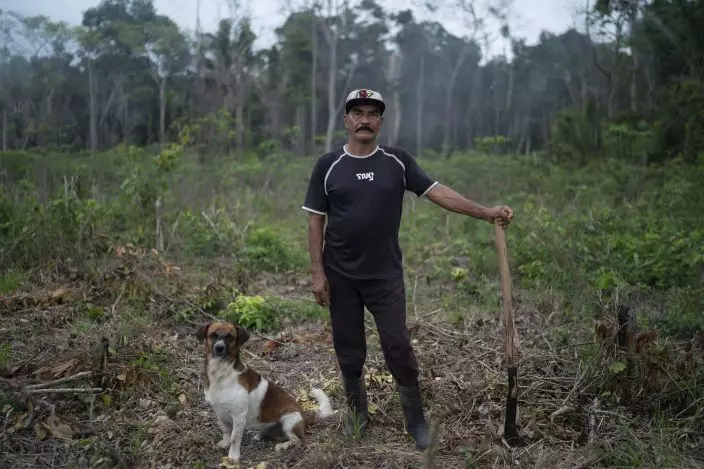
In this Nov. 20, 2019 photo, Valmir Lima de Souza poses with a sickle on his manioc plantation at the Curua-Una region in Santarem, Para state, Brazil. The 60-year-old small farmer, who has been working on this land for 48 years, says people have tried to buy his property, telling him that he has already raised his family and deserves to take a rest. "Man, I am already resting, because I didn't have water and light here, and now I have water and light and I am resting in my piece of land where I'm gonna stay. Making abundance, growing what I want to plant," says Souza. (AP PhotoLeo Correa)
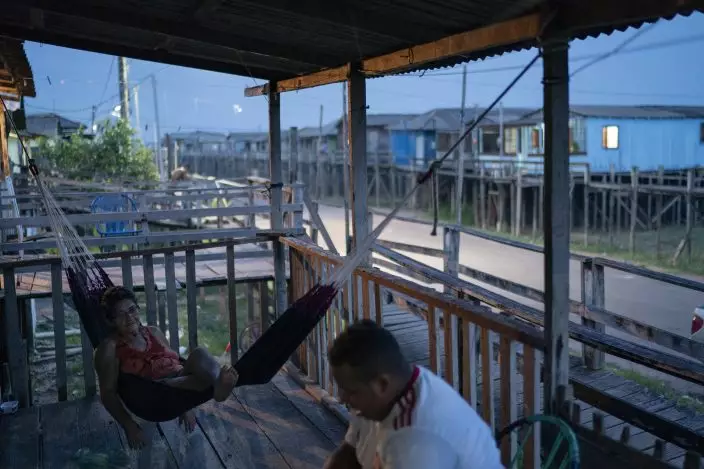
In this Nov. 27, 2019 photo, Antonia Pereira swings on her hammock as she talks with a friend on her stilt house at the Vila Nova neighborhood in Itaituba, Para state, Brazil. She says life was better in the 1980s when people came to the gold mines in the region. Now she survives selling hammocks and cooking street barbecues. Sometimes she can fish from her porch during the season that the Tapajos river floods. "I wish there were more jobs for the young people," she says. (AP PhotoLeo Correa)
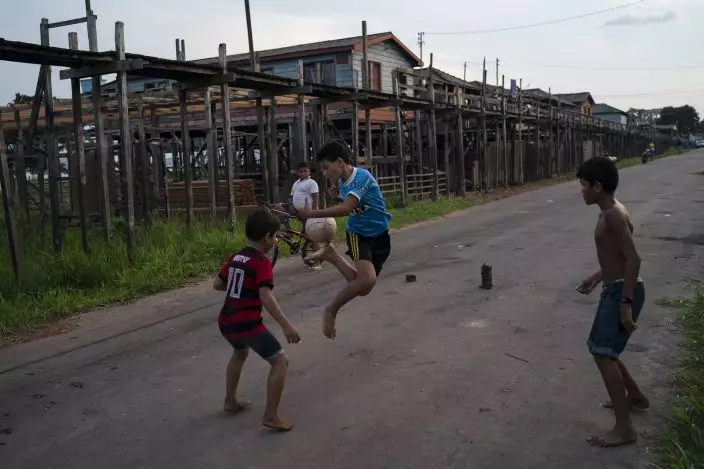
In this Nov. 27, 2019 photo, boys play soccer next to stilt houses at the Vila Nova neighborhood in Itaituba, Para state, Brazil. Carved through jungle during Brazil's military dictatorship in the 1970s, the Trans-Amazon highway that runs through town was built to bend nature to man's will in the vast hinterland. (AP PhotoLeo Correa)
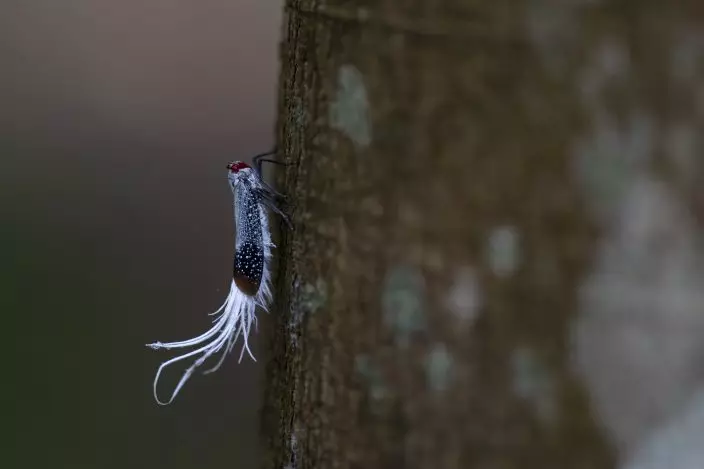
In this Nov. 30, 2019 photo, a rooster-tail cicada clings to a tree on the property of Joao Batista Ferreira in Belterra, Para state, Brazil. The area was jungle throughout Ferreira's childhood. Today, his plot is an island of shade and birdsong in the middle of sweeping plantations. (AP PhotoLeo Correa)
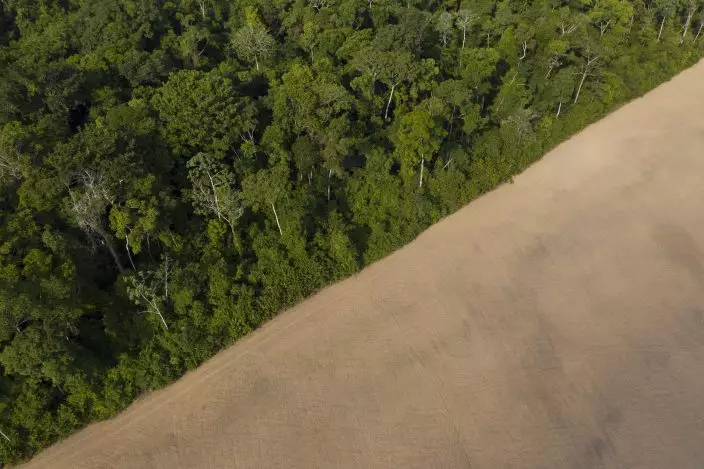
In this Nov. 30, 2019 photo, the forest stands next to a soy field in an area behind the home of Joao Batista Ferreira in Belterra, Para state, Brazil. Better known as Joao of Honey, though none of his 1,000 beehives remain, he complains that agribusiness did away with the native forest. (AP PhotoLeo Correa)


